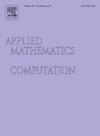Dynamics of cooperative evolution with leader-follower hierarchy under information uncertainty in two-layer grid networks
IF 3.4
2区 数学
Q1 MATHEMATICS, APPLIED
引用次数: 0
Abstract
Drawing on the idea of leader-follower game theory, this paper investigates the evolution of cooperative behavior in two-layer grid networks. The two-layer network is divided into a leader layer (upper layer) and a follower layer (lower layer), where the snowdrift game (SDG) and the prisoner’s dilemma game (PDG) are conducted, respectively. Based on an updating mechanism of the modified Fermi probability function that incorporates strategy alignment, the leader layer first completes strategy update, and the follower layer then updates its strategy after acquiring information from the upper layer via perception probability. Numerical simulations reveal that the cost-benefit ratio significantly influences the differences in perception strategies between layers. Specifically, at lower ratios, there is a positive correlation between followers’ cooperation and their perception probability, whereas leaders exhibit a negative correlation. The opposite trends are observed at higher ratios. Compared with single-layer networks, the leader-follower structure with two-layer networks significantly enhances the cooperation in the follower layer and also lightly fosters the cooperation in leader layer. Additionally, factors such as inter-layer coupling strength, rewards and punishments for strategy consistency, and selection intensity all promote the emergence of cooperation to varying degrees. This leader-follower hierarchical game offers a new research paradigm for interaction mechanisms in complex social systems.
信息不确定性下两层网格网络中具有领导-追随者层次的合作进化动力学
利用领导-追随者博弈论的思想,研究了两层网格网络中合作行为的演化。二层网络分为领导层(上层)和追随者层(下层),分别进行雪堆博弈(SDG)和囚徒困境博弈(PDG)。基于包含策略对齐的修正费米概率函数的更新机制,领导层首先完成策略更新,跟随层通过感知概率从上层获取信息后更新策略。数值模拟表明,成本-收益比显著影响层间感知策略的差异。具体而言,在较低的比例下,下属的合作与感知概率呈正相关,而领导者则呈负相关。在较高的比率上观察到相反的趋势。与单层网络相比,两层网络的领导-追随者结构显著增强了追随者层的合作,同时也轻微促进了领导层的合作。此外,层间耦合强度、策略一致性奖惩、选择强度等因素都不同程度地促进了合作的出现。这为复杂社会系统中相互作用机制的研究提供了一种新的研究范式。
本文章由计算机程序翻译,如有差异,请以英文原文为准。
求助全文
约1分钟内获得全文
求助全文
来源期刊
CiteScore
7.90
自引率
10.00%
发文量
755
审稿时长
36 days
期刊介绍:
Applied Mathematics and Computation addresses work at the interface between applied mathematics, numerical computation, and applications of systems – oriented ideas to the physical, biological, social, and behavioral sciences, and emphasizes papers of a computational nature focusing on new algorithms, their analysis and numerical results.
In addition to presenting research papers, Applied Mathematics and Computation publishes review articles and single–topics issues.

 求助内容:
求助内容: 应助结果提醒方式:
应助结果提醒方式:


